Danish Contractor
MTRAG: A Multi-Turn Conversational Benchmark for Evaluating Retrieval-Augmented Generation Systems
Jan 07, 2025



Abstract:Retrieval-augmented generation (RAG) has recently become a very popular task for Large Language Models (LLMs). Evaluating them on multi-turn RAG conversations, where the system is asked to generate a response to a question in the context of a preceding conversation is an important and often overlooked task with several additional challenges. We present MTRAG: an end-to-end human-generated multi-turn RAG benchmark that reflects several real-world properties across diverse dimensions for evaluating the full RAG pipeline. MTRAG contains 110 conversations averaging 7.7 turns each across four domains for a total of 842 tasks. We also explore automation paths via synthetic data and LLM-as-a-Judge evaluation. Our human and automatic evaluations show that even state-of-the-art LLM RAG systems struggle on MTRAG. We demonstrate the need for strong retrieval and generation systems that can handle later turns, unanswerable questions, non-standalone questions, and multiple domains. MTRAG is available at https://github.com/ibm/mt-rag-benchmark.
Reducing the Scope of Language Models with Circuit Breakers
Oct 28, 2024Abstract:Language models are now deployed in a wide variety of user-facing applications, often for specific purposes like answering questions about documentation or acting as coding assistants. As these models are intended for particular purposes, they should not be able to answer irrelevant queries like requests for poetry or questions about physics, or even worse, queries that can only be answered by humans like sensitive company policies. Instead we would like them to only answer queries corresponding to desired behavior and refuse all other requests, which we refer to as scoping. We find that, despite the use of system prompts, two representative language models can be poorly scoped and respond to queries they should not be addressing. We then conduct a comprehensive empirical evaluation of methods which could be used for scoping the behavior of language models. Among many other results, we show that a recently-proposed method for general alignment, Circuit Breakers (CB), can be adapted to scope language models to very specific tasks like sentiment analysis or summarization or even tasks with finer-grained scoping (e.g. summarizing only news articles). When compared to standard methods like fine-tuning or preference learning, CB is more robust both for out of distribution tasks, and to adversarial prompting techniques. We also show that layering SFT and CB together often results in the best of both worlds: improved performance only on relevant queries, while rejecting irrelevant ones.
Evaluating the Instruction-following Abilities of Language Models using Knowledge Tasks
Oct 16, 2024Abstract:In this work, we focus our attention on developing a benchmark for instruction-following where it is easy to verify both task performance as well as instruction-following capabilities. We adapt existing knowledge benchmarks and augment them with instructions that are a) conditional on correctly answering the knowledge task or b) use the space of candidate options in multiple-choice knowledge-answering tasks. This allows us to study model characteristics, such as their change in performance on the knowledge tasks in the presence of answer-modifying instructions and distractor instructions. In contrast to existing benchmarks for instruction following, we not only measure instruction-following capabilities but also use LLM-free methods to study task performance. We study a series of openly available large language models of varying parameter sizes (1B-405B) and closed source models namely GPT-4o-mini, GPT-4o. We find that even large-scale instruction-tuned LLMs fail to follow simple instructions in zero-shot settings. We release our dataset, the benchmark, code, and results for future work.
Multi-Document Grounded Multi-Turn Synthetic Dialog Generation
Sep 17, 2024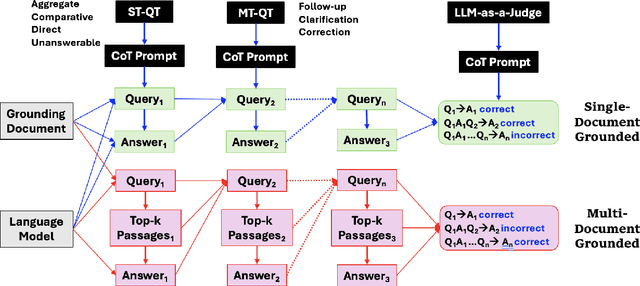


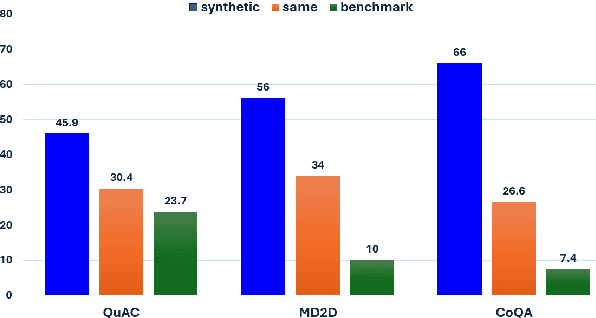
Abstract:We introduce a technique for multi-document grounded multi-turn synthetic dialog generation that incorporates three main ideas. First, we control the overall dialog flow using taxonomy-driven user queries that are generated with Chain-of-Thought (CoT) prompting. Second, we support the generation of multi-document grounded dialogs by mimicking real-world use of retrievers to update the grounding documents after every user-turn in the dialog. Third, we apply LLM-as-a-Judge to filter out queries with incorrect answers. Human evaluation of the synthetic dialog data suggests that the data is diverse, coherent, and includes mostly correct answers. Both human and automatic evaluations of answerable queries indicate that models fine-tuned on synthetic dialogs consistently out-perform those fine-tuned on existing human generated training data across four publicly available multi-turn document grounded benchmark test sets.
On the Standardization of Behavioral Use Clauses and Their Adoption for Responsible Licensing of AI
Feb 07, 2024Abstract:Growing concerns over negligent or malicious uses of AI have increased the appetite for tools that help manage the risks of the technology. In 2018, licenses with behaviorial-use clauses (commonly referred to as Responsible AI Licenses) were proposed to give developers a framework for releasing AI assets while specifying their users to mitigate negative applications. As of the end of 2023, on the order of 40,000 software and model repositories have adopted responsible AI licenses licenses. Notable models licensed with behavioral use clauses include BLOOM (language) and LLaMA2 (language), Stable Diffusion (image), and GRID (robotics). This paper explores why and how these licenses have been adopted, and why and how they have been adapted to fit particular use cases. We use a mixed-methods methodology of qualitative interviews, clustering of license clauses, and quantitative analysis of license adoption. Based on this evidence we take the position that responsible AI licenses need standardization to avoid confusing users or diluting their impact. At the same time, customization of behavioral restrictions is also appropriate in some contexts (e.g., medical domains). We advocate for ``standardized customization'' that can meet users' needs and can be supported via tooling.
Prompting with Pseudo-Code Instructions
May 22, 2023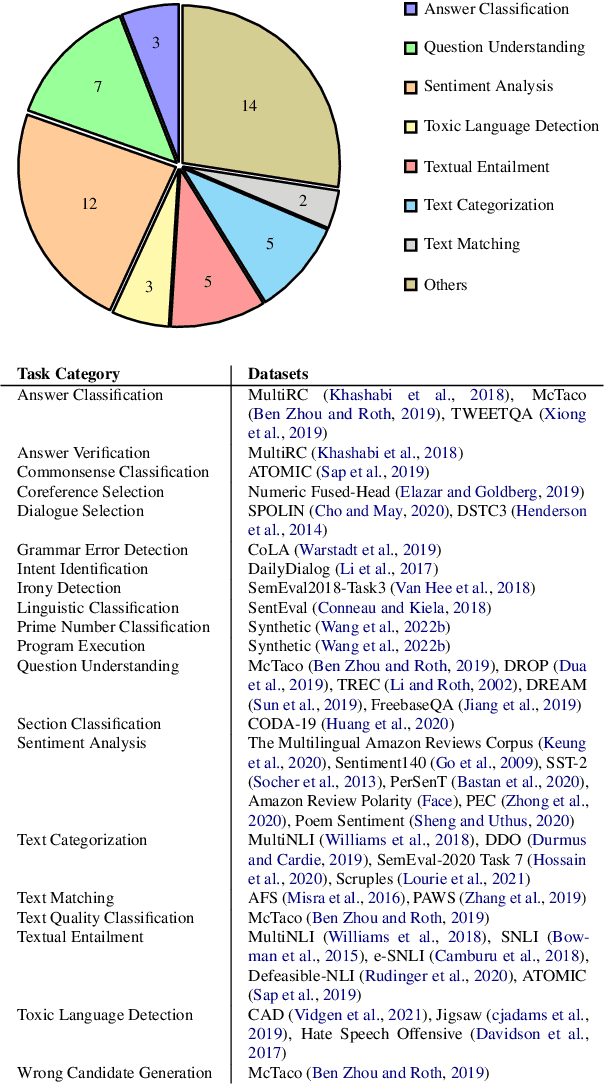
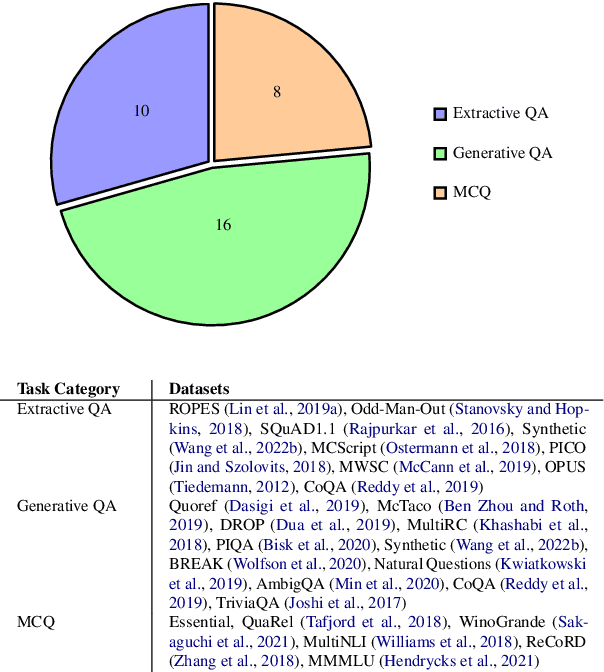
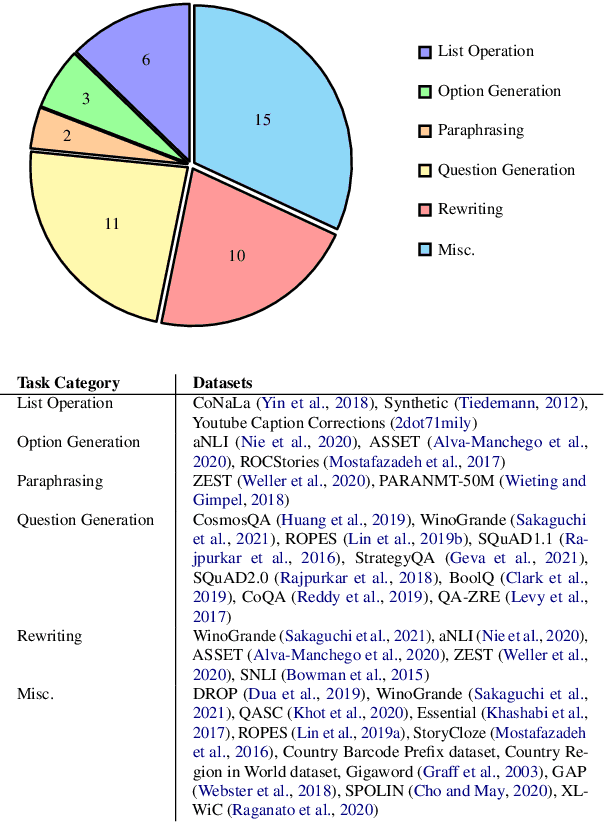
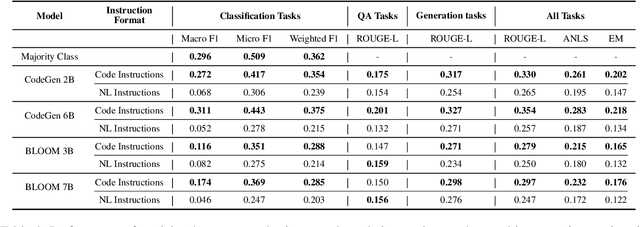
Abstract:Prompting with natural language instructions has recently emerged as a popular method of harnessing the capabilities of large language models. Given the inherent ambiguity present in natural language, it is intuitive to consider the possible advantages of prompting with less ambiguous prompt styles, such as the use of pseudo-code. In this paper we explore if prompting via pseudo-code instructions helps improve the performance of pre-trained language models. We manually create a dataset of pseudo-code prompts for 132 different tasks spanning classification, QA and generative language tasks, sourced from the Super-NaturalInstructions dataset. Using these prompts along with their counterparts in natural language, we study their performance on two LLM families - BLOOM and CodeGen. Our experiments show that using pseudo-code instructions leads to better results, with an average increase (absolute) of 7-16 points in F1 scores for classification tasks and an improvement (relative) of 12-38% in aggregate ROUGE-L scores across all tasks. We include detailed ablation studies which indicate that code comments, docstrings, and the structural clues encoded in pseudo-code all contribute towards the improvement in performance. To the best of our knowledge our work is the first to demonstrate how pseudo-code prompts can be helpful in improving the performance of pre-trained LMs.
StarCoder: may the source be with you!
May 09, 2023Abstract:The BigCode community, an open-scientific collaboration working on the responsible development of Large Language Models for Code (Code LLMs), introduces StarCoder and StarCoderBase: 15.5B parameter models with 8K context length, infilling capabilities and fast large-batch inference enabled by multi-query attention. StarCoderBase is trained on 1 trillion tokens sourced from The Stack, a large collection of permissively licensed GitHub repositories with inspection tools and an opt-out process. We fine-tuned StarCoderBase on 35B Python tokens, resulting in the creation of StarCoder. We perform the most comprehensive evaluation of Code LLMs to date and show that StarCoderBase outperforms every open Code LLM that supports multiple programming languages and matches or outperforms the OpenAI code-cushman-001 model. Furthermore, StarCoder outperforms every model that is fine-tuned on Python, can be prompted to achieve 40\% pass@1 on HumanEval, and still retains its performance on other programming languages. We take several important steps towards a safe open-access model release, including an improved PII redaction pipeline and a novel attribution tracing tool, and make the StarCoder models publicly available under a more commercially viable version of the Open Responsible AI Model license.
Semi-Structured Object Sequence Encoders
Jan 10, 2023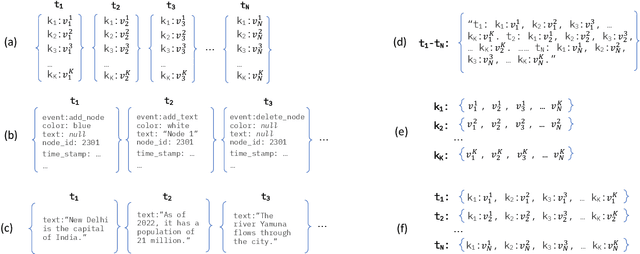

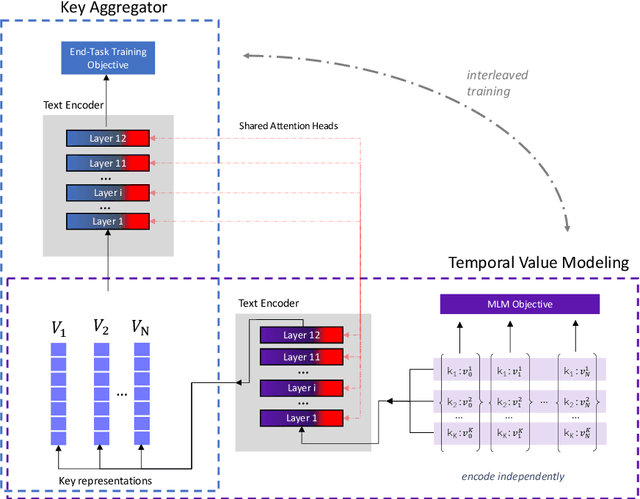
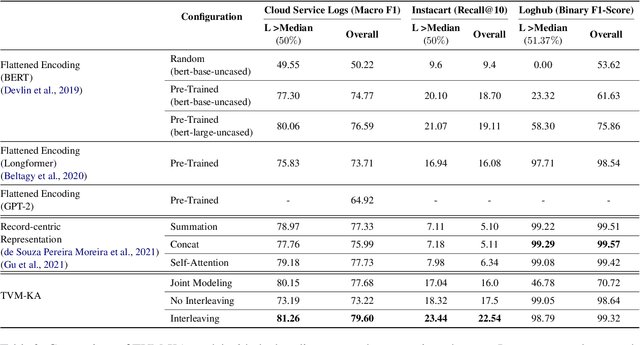
Abstract:In this paper we explore the task of modeling (semi) structured object sequences; in particular we focus our attention on the problem of developing a structure-aware input representation for such sequences. In such sequences, we assume that each structured object is represented by a set of key-value pairs which encode the attributes of the structured object. Given a universe of keys, a sequence of structured objects can then be viewed as an evolution of the values for each key, over time. We encode and construct a sequential representation using the values for a particular key (Temporal Value Modeling - TVM) and then self-attend over the set of key-conditioned value sequences to a create a representation of the structured object sequence (Key Aggregation - KA). We pre-train and fine-tune the two components independently and present an innovative training schedule that interleaves the training of both modules with shared attention heads. We find that this iterative two part-training results in better performance than a unified network with hierarchical encoding as well as over, other methods that use a {\em record-view} representation of the sequence \cite{de2021transformers4rec} or a simple {\em flattened} representation of the sequence. We conduct experiments using real-world data to demonstrate the advantage of interleaving TVM-KA on multiple tasks and detailed ablation studies motivating our modeling choices. We find that our approach performs better than flattening sequence objects and also allows us to operate on significantly larger sequences than existing methods.
SantaCoder: don't reach for the stars!
Jan 09, 2023



Abstract:The BigCode project is an open-scientific collaboration working on the responsible development of large language models for code. This tech report describes the progress of the collaboration until December 2022, outlining the current state of the Personally Identifiable Information (PII) redaction pipeline, the experiments conducted to de-risk the model architecture, and the experiments investigating better preprocessing methods for the training data. We train 1.1B parameter models on the Java, JavaScript, and Python subsets of The Stack and evaluate them on the MultiPL-E text-to-code benchmark. We find that more aggressive filtering of near-duplicates can further boost performance and, surprisingly, that selecting files from repositories with 5+ GitHub stars deteriorates performance significantly. Our best model outperforms previous open-source multilingual code generation models (InCoder-6.7B and CodeGen-Multi-2.7B) in both left-to-right generation and infilling on the Java, JavaScript, and Python portions of MultiPL-E, despite being a substantially smaller model. All models are released under an OpenRAIL license at https://hf.co/bigcode.
BLOOM: A 176B-Parameter Open-Access Multilingual Language Model
Nov 09, 2022Abstract:Large language models (LLMs) have been shown to be able to perform new tasks based on a few demonstrations or natural language instructions. While these capabilities have led to widespread adoption, most LLMs are developed by resource-rich organizations and are frequently kept from the public. As a step towards democratizing this powerful technology, we present BLOOM, a 176B-parameter open-access language model designed and built thanks to a collaboration of hundreds of researchers. BLOOM is a decoder-only Transformer language model that was trained on the ROOTS corpus, a dataset comprising hundreds of sources in 46 natural and 13 programming languages (59 in total). We find that BLOOM achieves competitive performance on a wide variety of benchmarks, with stronger results after undergoing multitask prompted finetuning. To facilitate future research and applications using LLMs, we publicly release our models and code under the Responsible AI License.
 Add to Chrome
Add to Chrome Add to Firefox
Add to Firefox Add to Edge
Add to Edge